It’s a fish that lived alongside dinosaurs, and held its own: A slimy and voracious creature with a mouth full of sharp teeth.
And you don’t have to wait for Jurassic Park to see one: the bowfin is still among us. It has proven tougher than T. rex. But is it tough enough to survive humanity?
I recall well my first encounter: pulling that bizarre fish with the long dorsal fin into a boat, as part of fish surveys I was conducting on Michigan’s Muskegon River. I’d read about these fish before in class, but had never seen one alive.
I just had to get a better look at this fish. And that was the beginning of my fascination with this incredible, but often underappreciated, animal.
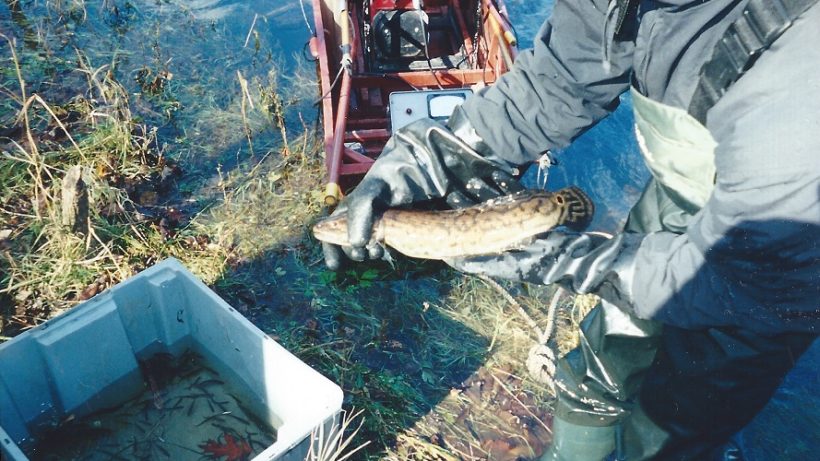
Mudfish, dogfish, grinnel, swamp-muskie: the names alone suggest why bowfin (Amia calva) are generally not the most highly-revered among fishes.
With their prehistoric appearance and tenacious attitude, one may say they deserve their poor reputation. But the bowfin is in reality a fascinating, resilient, and even beneficial species.
What we see today in the backwaters and wetlands of eastern North America is a modern representative of a very ancient line of “primitive” fishes or “living fossils,” organisms that appear to have changed little over time. The sole remainder of a once diverse group; bowfins (order Amiiformes), have been around for over 150 million years.
Bowfin look the part of a living fossil, too. In fact, they’re full of fascinating features that have captivated my fishy imagination.
Distinguishing the bowfin from your typical “gamefish,” Amia calva possesses an elongate dorsal fin, which is capable of near-hypnotic undulations (I recommend checking them out in a public aquarium and this video), allowing the fish to swim backward just as easily as forward.
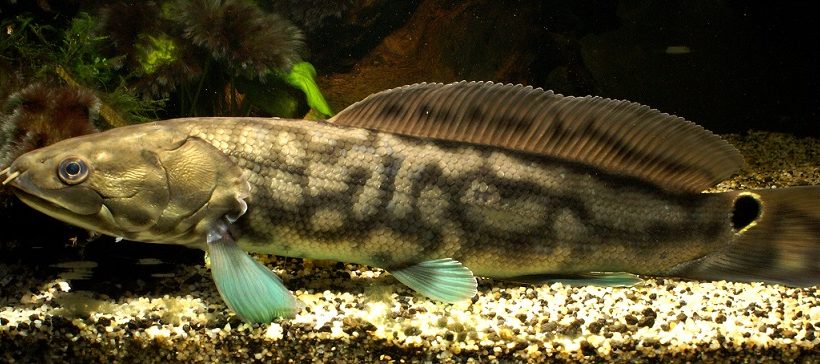
Photo: Solomon David
This comes in handy when navigating their preferred, highly-vegetated habitats. Adding to a glamorous appearance only a mother (and a few of us bowfin enthusiasts) could love, Bowfin have tubular nostrils on a bony, rounded head; their sense of smell is much better than their eyesight.
They are also quite strong and slimy, so getting a grip on them, whether predator, angler, or fisheries biologist, can be quite challenging!
Other notable features include a bony plate on the lower jaw, known as the “gular plate”, and a yellow-ringed eye-spot or ocellus, found near the tail in juveniles and males (the ocellus is often absent or reduced to a black blotch in mature females).
The function of this eye-spot may be two-fold. First, the camouflage of a false eye near the tail can misdirect an attacking predator. It’s easier to regrow you tailfin than your head!
This feature comes in handy particularly for young-of-year bowfin.
And it may help young bowfin in another way. The eye-spot on the male may serve as a homing pattern for young bowfin to follow; after all, it is the male bowfin that aggressively guards the nest once eggs are laid, and then shepherds around the young fish in a massive “bowfin ball” until they reach 2-3”in length and disperse.
This behavior is unique in that it is the only occurrence of parental care in surviving “primitive” ray-finned fishes (e.g. sturgeons, paddlefish, polypterids, and gars).
Bowfin also possess adaptations which have probably helped them persist from dinosaur to modern times. Sure, there’s the tenacious attitude and seemingly insatiable opportunistic appetite. But they can also breathe air using an organ called a modified gas bladder, which can be used like a SCUBA tank.
Whereas most fishes must acquire oxygen from water using their gills, Bowfin can gulp air from the surface, temporarily storing it in their blood-vessel-rich gas bladder, which works like a lung.
When oxygen in the tank is used up, they return to the surface, releasing the O2-depleted air out the gill chambers and gulping new air through the mouth. This adaptation allows Bowfin to persist in warmer, low-oxygen waters, where more conventionally-breathing fishes (like perch, bass, or walleye) may be unable to survive.
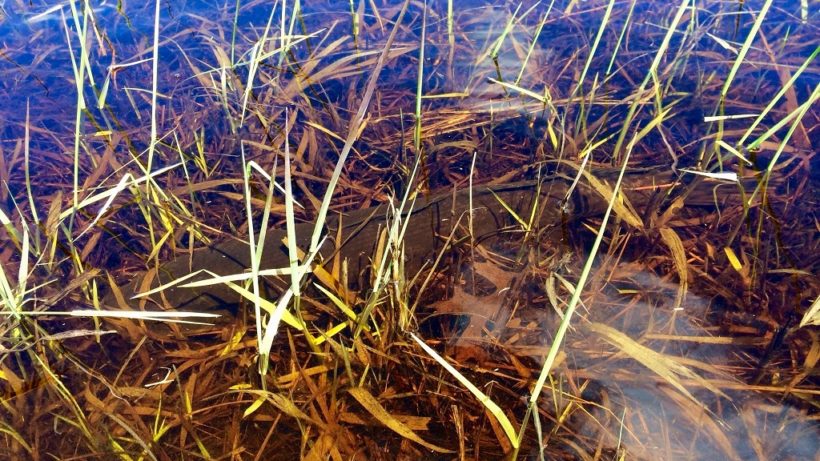
The bowfin lineage has persisted for over 150 million years, surviving extinction events that killed the dinosaurs and many other species, but can they survive this modern age of humans?
Bowfin have a bad reputation for supposedly negatively impacting sportfish populations by eating young game fish and game fish food; in some cases they are blamed for “taking over” entire lakes and backwater habitats.
The science, however, has shown otherwise; indicating bowfin, like other well-known predators (such as pike and muskellunge) will eat whatever prey is most abundant, including crustaceans (crayfish, freshwater shrimp), forage fish (shad, minnows), or game fish.
In doing so, bowfin can help prevent the overpopulation of forage fishes and stunting in game fishes such as sunfish and bass, therefore maintaining a balanced ecosystem. I highly recommend reading Scarnecchia’s essay, “Reappraisal of Gars & Bowfin in Fishery Management,” which delves much deeper into this oft-debated topic.
It is unfortunately often a familiar theme for fish conservationists: a native fish blamed for crimes it didn’t commit.
It is unfortunately often a familiar theme for fish conservationists: a native fish blamed for crimes it didn’t commit.
Aside from the eradication activities mentioned by Scarnecchia 1992 (some as extreme as dynamite blasting!), other current threats are habitat loss and wasteful harvest. Why are these two issues important to anglers and nature enthusiasts, and what are scientists doing about it?
Habitat loss is one of the primary threats to biodiversity worldwide, whether in rainforests, coral reefs, or the backwaters of eastern North America. Those highly vegetated habitats preferred by Bowfin are also nursery areas for young game fish species.
When we use herbicides to clear vegetation for boats, or fully drain and develop wetland sites, we are often negatively impacting native biodiversity, ecosystem function, and the balance of food webs (including “popular” game fish species). These activities also tend to pave the way for invasive species, since a less resilient ecosystem is often more vulnerable to invasion.
However, hope is not lost for bowfin and residents of these vegetated habitats!
Collaborative research by The Nature Conservancy, Shedd Aquarium, and University of Wisconsin (Green Bay & Madison) is investigating the efficacy of restoration wetlands, providing spawning habitat for migratory fishes such as northern pike.
So far we’ve found that if we create new habitat, the fishes will come; this includes our native underdog, the bowfin.
Over the past three years we have not only recorded the first observations of bowfin in these restoration habitats, but also successful natural reproduction and site fidelity (returning to the same site annually).
These findings are important as they indicate several fish species quickly take advantage of newly available habitat, scoring some points for restoration efforts!

Wasteful harvest (and sometimes flat-out eradication) is also a threat to bowfin. Because they aren’t considered traditional “game fish” (a term that’s highly relative, and should indeed be applied to Bowfin), alternative methods of harvest are often used (and legal) for the species, such as bowfishing.
Although many bowfishers eat what they catch (I’ve had fried Bowfin and it’s delicious), some do not, and the fish are often discarded or turned into fertilizer.
Wouldn’t native apex predators do more good maintaining balance in ecosystems and food webs than pushing up agriculture?
It’s hard to say how much bowfishing and other harvest methods impact Bowfin, although previous research indicates they typically make up a small percentage of resident fish populations.
At the very least, they aren’t deserving of wasteful eradication by some anglers who might consider them “trash fish”. A bass fisherman would never dream of catching a muskie and discarding it because it eats bass, so why consider bowfin in such a light?
Once again, fisheries scientists and ecologists are working toward a balance for management of this natural resource. The Sport Fish Ecology Lab at the Illinois Natural History Survey has initiated the Ancient Sport Fish Project to assess bowfin (and gar) populations throughout the state to better understand population status and trends, as well as informing the potential for management strategies that create a sustainable ancient sport fishery.
The goal of this project is to gather the missing data managers will use to develop options for sustainable harvest while maintaining balanced food webs.
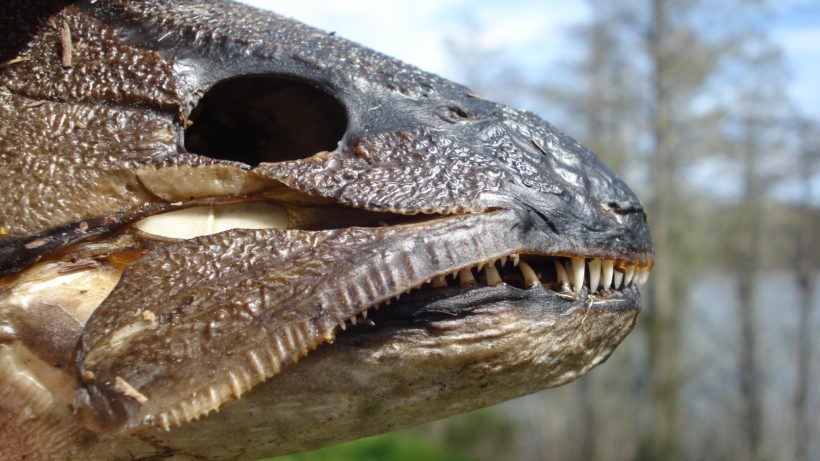
Ancient survivors representative of native biodiversity much older than ourselves, Bowfin have indeed outlasted T. rex and friends. They possess adaptations that give them home-pond advantage over the typical perch or bass. Their persistence, however, requires us to be proper stewards of our environment, conserving creatures whether they are charismatic megafauna or backwater underdog.
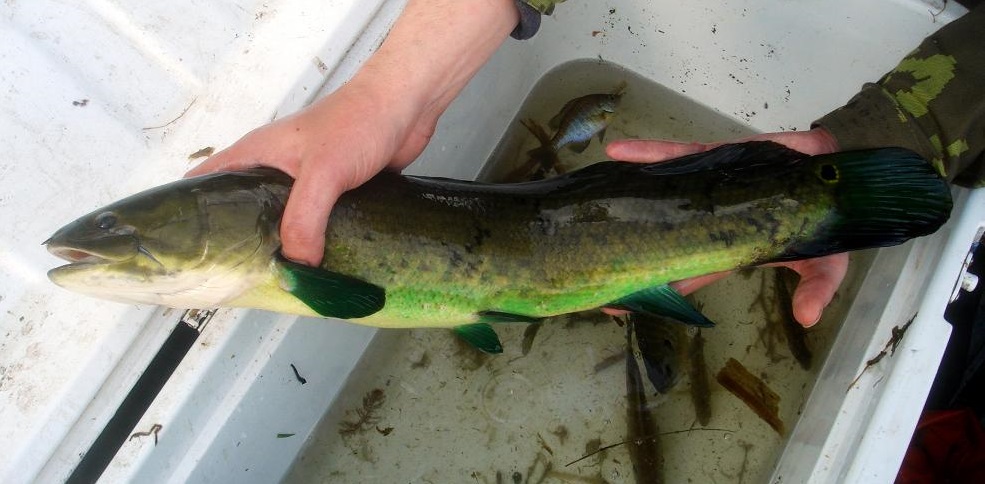



I fish a lake in Michigan, i have been doing so for nearly 50 yrs, my experience in fishing for pike and bass is that if I don’t catch or have a hit the bowfin are usually in the area, and I will catch one or see them surface, as if they are watching me, I have cought some big ones,
My son and I like to catch bowfin with night crawlers typically in July at dusk. I have seen them thrown onto the shore to die. We always put them back after we catch them. They put up a good fight and are fun to catch. Interesting looking fish also.
Managed to catch my first bowfin yesterday. I’d say it was about 26-28″ long, didn’t have the slightest idea what is was till I arrived back home and looked it up in a book of Wisconsin fishes. I caught this bowfin in Mississippi River backwater. Was a female as I didn’t notice the eye spot on the rear, it’s teeth seemed to be worn but still present. I only fish and release so she’s still out there to give a thrill to another fisherman. Absolutely a cool fish that I hope survives another 150 million years.
Not a fisherwoman, but I live near Dead Creek in Vermont. I am fascinated by the creatures there, love to go there just to see what is thrashing around. Now I will have to get out there to see if I can see bowfin. Especially a guy bowfin with a ball of babies.
Been some years since I’ve poked around, and then I was looking more at bird tracks and startling carp buried in the mud. Didn’t know a thing about these freshwater “rough fishes” and still don’t know much, at least about eastern freshwater varieties (some western saltwater fish have, um, an interesting appearance.
While I get the “rough” appellation, I don’t get why the word ugly is attached! They may not be graceful looking, but they still have a beauty that to my eye, is common to all fishes.
Great article on the bowfin, thanks for writing and posting it.
If bowfin grew to the sizes attained by catfish and other large fish they would be the only species I would ever seek out to catch and of course release. I’m a native of southwest Indiana where I still live and fish today. Been at it for 30 years and counting. The bowfin, which I call grinell or cypress trout, is one of the most misunderstood and underrated fish that swims. They have a bad attitude and all the other qualities that define a gamefish yet most anglers despise them and just leave them on the bank to die. My area is blessed with giants and I’ve caught and released many that would have shattered the state record and a few that I believe would have been world records by a nice margin. Hopefully one day folks will realize these fish are a treasure that should be given the same respect as any other gamefish.
Great fighting fish
Turning wonderful bowfins into fertilizer…. My heart bleeds! These animals are unique (same as gars) and deserve preservation instead of dynamite fishing.